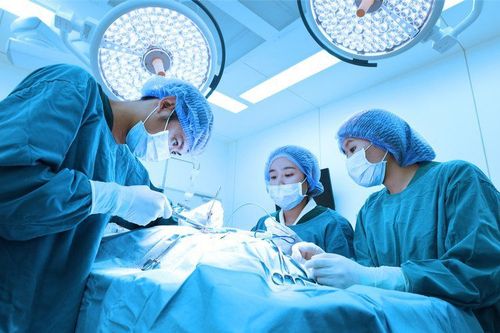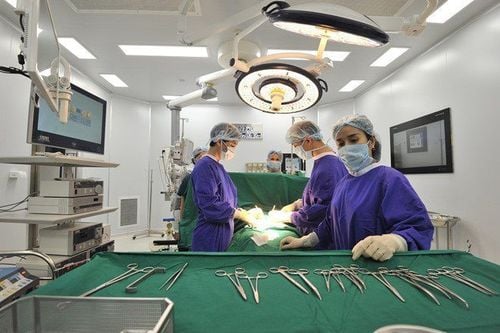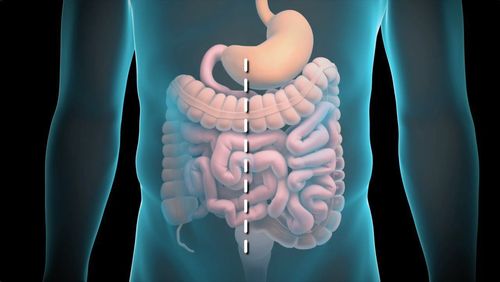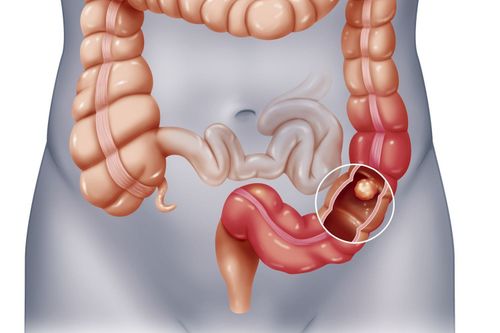This is an automatically translated article.
Postoperative intestinal dissection is a surgical surgery with the aim of separating as much as required, according to abdominal anatomy to expose the viscera, mesenteric mesentery, and visceral peritoneal wall, abdominal cavity to carry out therapeutic purposes. Postoperative intestinal dissection is a surgery that is often performed with other surgical procedures in the same operation.
Postoperative intestinal adhesion is a phenomenon in which the structures in the abdominal cavity stick together at different levels of complexity, causing twisting and twisting after the impact of previous surgeries, surgery or post-operative pathology. caused development. Surgery to remove intestinal adhesions can be open surgery, laparoscopic surgery, or extraperitoneal laparoscopic surgery depending on the specific condition of the patient and the doctor's instructions.
1. Indications for surgical removal of intestinal adhesions
In the following specific cases, the patient is indicated to perform surgical dissection of intestinal adhesions:
Intestinal adhesions, visceral adhesions or peritoneal adhesions requiring dissection in abdominal surgeries. Adhesions to the abdomen must be dissected to release the mesenteric visceral blood vessels to treat diseases and complications. Adhesion of the abdomen, release of blood vessels of the damaged visceral lymph nodes to diagnose the disease, perform a biopsy of the lesion to remove the lesion to drain the outbreak or shape it in surgical operations. Surgical removal of intestinal adhesions has no absolute contraindications, but doctors and technicians need to analyze and consider the implementation to ensure safety for the patient and achieve high treatment efficiency.

Phẫu thuật gỡ dính ruột có thể mổ mở hoặc mổ nội soi ổ bụng, hoặc nội soi ngoài phúc mạc tùy vào tình trạng cụ thể của bệnh nhân
2. Prepare
Performing intestinal adhesion removal after surgery is a surgical surgeon who is fully trained in a specialty level I or equivalent with experience, along with 2 surgical assistants and an anesthetic resuscitation team, with enough equipment for the surgery. abdominal surgery.
For patients before surgery, it is necessary to fast for 6 hours before surgery, clean the whole body and one area. In addition, it is necessary to check before performing anesthesia and surgery.
The necessary equipment in the surgery to remove intestinal adhesions to prepare include:
Basic laparotomy kit for open surgery, laparoscopic surgery kit for laparoscopic dissection. Electric scalpel (with long handle), high-tech knives such as bi-polar ligasure knife to perform surgery in deep and difficult locations or requiring detailed hemostasis when removing adhesions, intestinal sutures, vascular sutures associated with difficult cases requiring recovery. Laparoscopic surgery set, non-traumatic surgical forceps, surgical instruments such as electric hooks, electric spatule, electric scissors, surgi-wan with dissection with suction cleaning... depending on the needs of the surgeon Operating table Versatile to adjust to many positions of rotation, foot shape.

Thực hiện gỡ dính ruột sau mổ là bác sĩ phẫu thuật ngoại khoa có kinh nghiệm với đầy đủ trang thiết bị
3. Steps to take
Put the patient in the supine or supine position on the multi-function operating table, which can be changed. Conduct general anesthesia, combine techniques for pain relief after a session, muscle relaxation, and surgical resuscitation to ensure the best ventilation for the patient. Avoid the risk of congestive edema of visceral suspension to ensure a safe prolongation of surgery during the operation. Performing the technique: Step 1: Open the abdomen, you need to choose the incision position and width to open the abdomen most suitable. Open the abdomen according to the principle from the outside and the inside to go through anatomical layers, both opening and removing adhesions, starting from the least adhesion. Step 2: Remove adhesions of the omentum, mesentery, abdominal wall, viscera, enter the correct dissection layers of the original embryological anatomy, dissect all adhesions according to the requirements of the indication, limit minimize the impact of damage to organs, blood vessels, nerves, and lymphatics. Step 4: Remove complex lesions due to difficult torsion, high risk or affected by disease progression after previous surgery. This is the most difficult and complex technique that requires technical concentration. Step 5: Abdominal aspiration can drain to limit adhesion, it is necessary to arrange the mesenteric visceral intestine according to the correct anatomy. Step 6: Close the abdomen according to the anatomical layers. This step, if it is difficult to close the abdomen, may require additional surgery to restore the abdominal wall.
4. Monitoring and handling of accidents
After surgery to remove intestinal adhesions, the patient should be monitored according to the principle of one abdomen. Accordingly, the patient is nourished after surgery by intravenous route until normal bowel movements return. Incisions, gastric tubes need to be cared for and monitored until the patient is stable, then withdrawn. In addition, it is necessary to monitor clinical signs of vomiting pain, abdominal distension after surgery, local infection syndrome, defecation, etc. to detect early abnormal complications if any after surgery.
Some common complications after surgery to remove intestinal adhesions such as:
Complications of intestinal obstruction after surgery: The patient has symptoms of pain, vomiting, bowel obstruction, abdominal distension... , this case needs early treatment of intestinal obstruction, resistance give gastric suction to the patient and monitor. Complications of intestinal perforation, peritonitis, intra-abdominal bleeding, wound rupture, functional bowel paralysis. Water and electrolyte disorders, functional renal failure, malnutrition, need timely correction.
Please dial HOTLINE for more information or register for an appointment HERE. Download MyVinmec app to make appointments faster and to manage your bookings easily.













